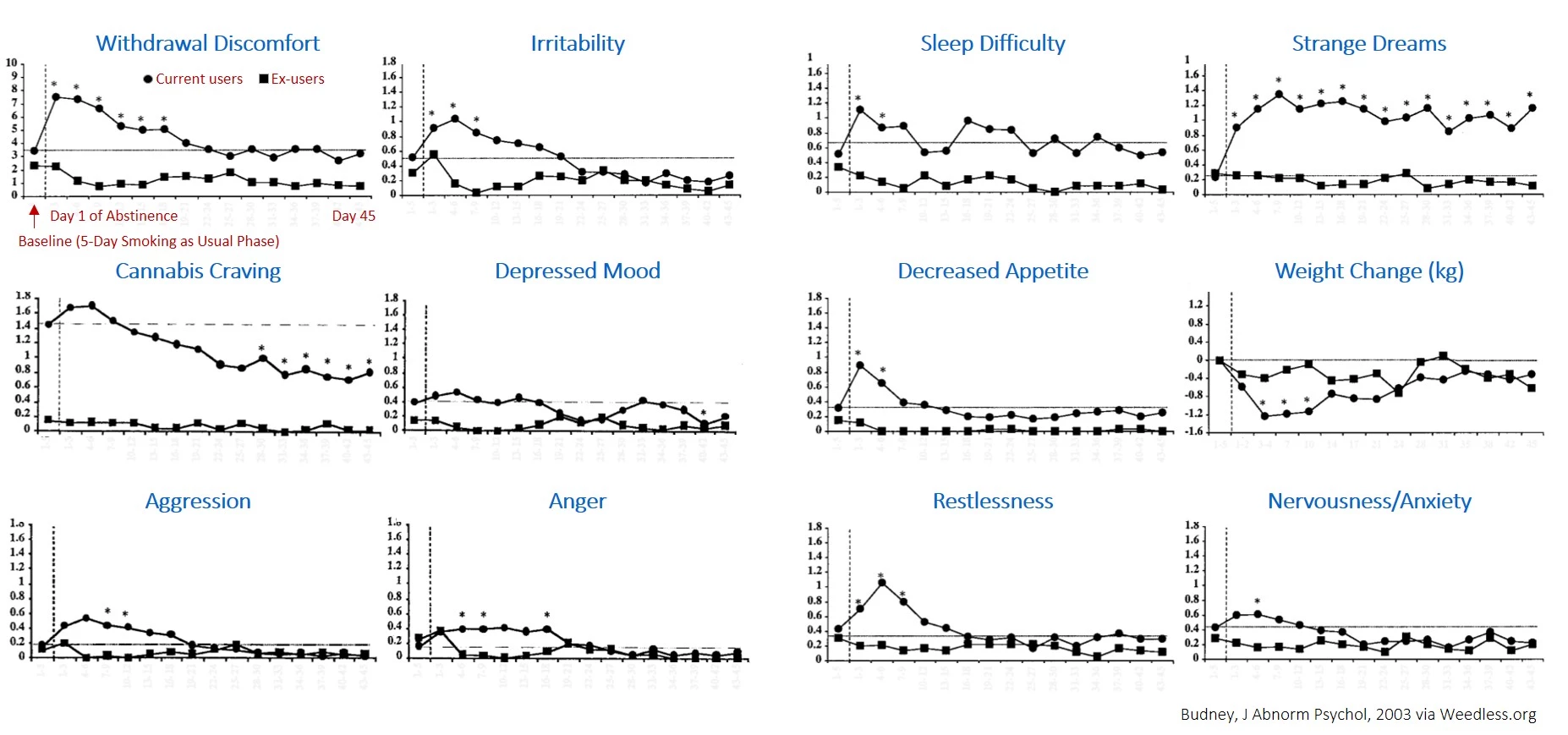Home » Weed Withdrawal » Weed Withdrawal Timeline
What Happens When You Stop Smoking Weed Timeline

Editorial Oversight By Leah Zuroff, M.D., M.S.

The first days and weeks after quitting marijuana can be a rollercoaster of thoughts, physical symptoms, and emotions. Though we provide a general timeline of typical withdrawal symptoms, everyone is different. Your experience with withdrawal is influenced by how much and how long you’ve used as well as a host of biological and psychosocial factors that make your experience wholly unique. So, use this as a general outline to mentally prepare yourself for what’s to come, but don’t be alarmed if your experience is a little different. Generally, symptoms of withdrawal begin within the first 24 hours of abstinence, peak by day three and can last for up to two to three weeks or longer.
Timeline of Common Withdrawal-Related Side Effects in Heavy Users
An outpatient study assessing 18 regular marijuana users (and 12 former marijuana users) found that withdrawal symptoms most often appeared between days 1-3, peaked between days 2-6, lasted 4-14 days (Budney, J Abnorm Psychol, 2003). In the study, participants completed a 5-day “smoking-as-usual” phase followed by a 45-day abstinence phase. A withdrawal pattern was observed for aggression, anger/irritability, anxiety, decreased appetite, irritability, restlessness, shakiness, sleep problems, and stomach pain.
Click Image to Enlarge
The First 24 to 72 Hours
Symptoms of marijuana withdrawal typically begin within the first three days of stopping. In the first few days, you can expect to experience difficulty sleeping, difficulty concentrating, and irritability or anxiety. Cravings are expected. You may also find that you have abdominal pains, nausea or vomiting, shakiness or headaches. All of these symptoms, including both the psychological and physical, will intensify over the course of days, with most peaking at 3 days, or 72 hours after quitting.
This initial period and can be very distressing for people who are experiencing multiple withdrawal effects. While there is still a long way to go, making it through this acute phase of withdrawal is a substantial achievement, and it is all the more important that you stick to your routines as you progress through the stages of recovery.
The First Week to Month
By the end of your first week, most of the physical symptoms of withdrawal will have begun to show signs of improvement—for some, these will go away completely. Even so, people may continue to struggle with sleep, lack of energy, or loss of appetite. In some people, decreased appetite may even result in significant weight loss.
By your second week, your symptoms should be must less intense than the first week, and any flu-like symptoms (changes in body temperature, headaches) will have dissipated by now. You may begin to feel restlessness, boredom, and depression creeping in. Cravings, will continue, and you should anticipate intense and sporadic cravings throughout this time.
By weeks three and four, the most pronounced symptoms are sleep disturbances, depression and anxiety, and mental clouding, or brain fog. Sometimes, sleep disturbances and brain fog can persist for months. It may appear that there is no end in sight. Even so, we want to emphasize that, after four weeks of abstinence, the worst is behind you. We promise there is light at the end of the tunnel, so stick with it!
What to Expect After a Month
After one month of successful abstinence, you’ve essentially scaled the mountain of withdrawal, and the majority of withdrawal symptoms will have subsided by now. The worst and darkest times are now behind you, and it might be around now that you are starting to see all the ways in which quitting marijuana use has already begun to alter your life for the better. Perhaps you’ve replaced some of your previous habits with health-promoting activities like exercise. Perhaps you’ve started to wake up feeling more positive or even gotten more accustomed to seeing things in a positive light. If so, congratulations. When a craving strikes, employ that method or healthy distraction you’ve practiced again and again. You’re finally on the road to the new, cleaner you, and there’s no reason to look back.
For some people, though, symptoms of withdrawal will drag on past this one-month mark. These include mood symptoms like depression, irritability, as well as continued difficulties with sleep, or vivid dreams. Some studies have noted that other symptoms, like fatigue, sneezing, or coughing can happen after a month (Hesse, BMC Psychiatry, 2013). Other former users, especially those who have a history of heavy marijuana ingestion, may continue to struggle with memory and cognition, although they will have made substantial improvements from the acute withdrawal period (Broyd, Biol Psychiatry, 2016).
Importantly, persistent physical pain, nausea, vomiting or weight loss that interferes with your ability to function is concerning and should be brought to the attention of a healthcare provider. These may represent symptoms of another condition, as typical marijuana withdrawal symptoms should be self-limited, and not so severe.
Similarly, though some continued mood changes are entirely normal, there is a huge difference between depressed mood secondary to withdrawal and clinical depression. If you are still feeling down, hopeless, and fatigued after one month, you may be experiencing something more serious. Please do not hesitate to call your doctor if you feel like your mood is interfering with your ability to function in the world. Most importantly, if you ever being to wonder whether life is worth living or begin to have thoughts of harming yourself or others, these are not feelings that you can or should deal with alone. Please, do not hesitate to seek help.
National Suicide Prevention Lifeline: 1-800-273-8255
Can Withdrawal Be Prevented?
Many people will want to know if withdrawal is preventable. Unfortunately, the short answer is that there is no guaranteed strategy or medication that will completely eliminate the symptoms of withdrawal. While some medications have been investigated as potential treatments for cannabis use disorder or cannabis withdrawal syndrome, these are largely limited to reducing a specific symptom, like dulling your cravings, or enhancing sleep.
If you plan on quitting, the best way to minimize the symptoms of withdrawal are to optimize your environment, and to consider whether you may benefit from reducing your use before quitting entirely. In The Weedless Guide, we explain how taking smart measures before you stop—whether that’s planning your timeline, or throwing out your marijuana related equipment—can minimize the mental and physical triggers that can activate cravings, exacerbate mood changes, and interfere with your daily routines. Similarly, you can decrease the potential severity of withdrawal by gradually reducing your use rather than quitting abruptly or “cold turkey,” as withdrawal severity tends to correlate with how much you use. Remember though, that with marijuana dependence, even just cutting down on how much you smoke can lead to some withdrawal, and you shouldn’t take that as an indication to keep smoking!
Ultimately, being well informed, well prepared, and committed to your goal is the best you can do before your take on the challenges of withdrawal. As you progress, keep reminding yourself that this is what you expected, and that you are equipped with everything you need to battle those temporary discomforts. There are a lot of people, including us, who promise to be there each step of the way.

Are you a regular marijuana user that has recently stopped using?
Currently, little data exists on heavy marijuana use and withdrawal. Weedless.org is collaborating with researchers to explore this topic and others. We have created a short, completely anonymous questionnaire which we will use to focus our future research efforts. You may skip any questions that make you feel uncomfortable and you are free to withdraw at any time. At the end of the survey, you will be given the option to anonymously share your responses with the Weedless.org community.
About Marijuana Withdrawal
Marijuana withdrawal is the body’s reaction to a sudden decrease in its baseline level of marijuana. From a simplistic biologic explanation, this means that the cell receptors and pathways that are normally always tuned to ‘high’ are suddenly turned to ‘low’. A good example of this leaving a loud concert and noticing that everything sounds muffled. While at first, you might be worried that you’ve suddenly gone deaf, your hearing eventually returns, and the ambient noises of daily life return to their normal volume.
